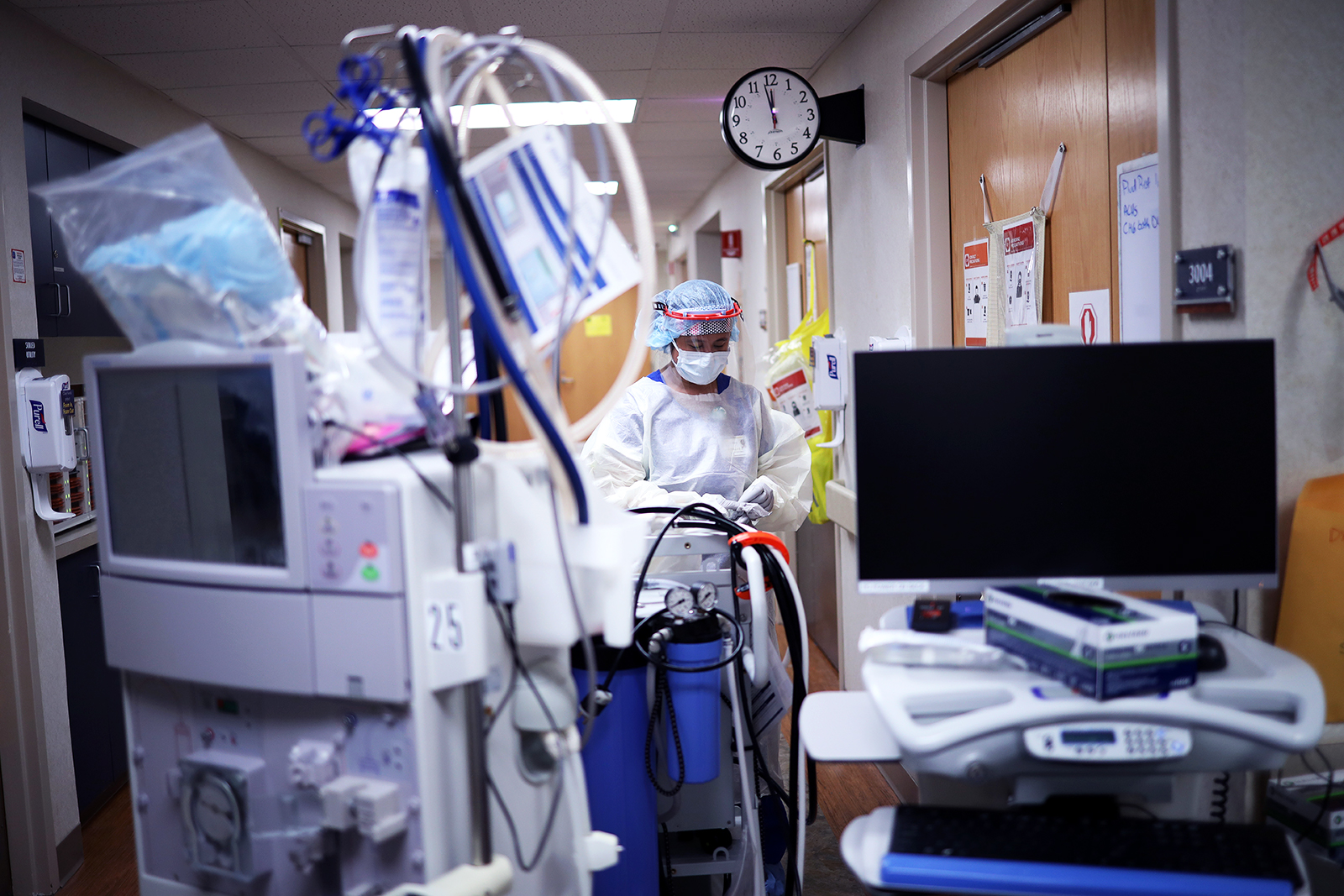Hospitals and Health Care Face Increasing Cybersecurity Risks

Hospital staff prepares to treat a patient with coronavirus in the intensive care unit at a hospital on May 1, 2020, in Maryland. Since the onset of COVID, the rate of ransomware attacks has soared across all industries — and health care has been the disproportionate target of such attacks.
Photo: Win McNamee/Getty Images
The fuel shortages and rising gas prices generated by the Colonial Pipeline ransomware attack in May foreshadow the disastrous and far-reaching effects of cyberattacks on critical infrastructure. SolarWinds, JBS, Kaseya and a torrent of other high-profile cyber incidents have captured the attention of the American public and the highest levels of government, leading to a flurry of federal actions — including the nomination of the first-ever National Cyber Director, formal attribution of the SolarWinds attack to Russia, the release of an executive order imposing new security standards for software on federal procurement lists and a host of legislative proposals to improve the nation’s cybersecurity.
Though these prominent cyber incidents have triggered several cybersecurity initiatives, policymakers have paid relatively little attention to the considerable potential cyber risks in the health care sector. The WannaCry ransomware attack, which took down the United Kingdom’s National Health Service in 2017, served as a wake-up call to health care organizations around the world, illuminating the urgent need for proactive investments in cybersecurity. And yet, health care organizations in the U.S. remain a vulnerable target, lagging behind other industries on key measures of cyber-readiness.
As the resurgence of COVID-19 cases stretch hospital capacity to the limit, it provides a fresh reminder of just how critical it is for our health care infrastructure to be resilient in times of crises. With the sharp uptick in ransomware attacks on health care organizations during the pandemic — and the first death attributed to a ransomware attack in 2020 — it is clear that that malicious actors are capable of compromising mission-critical health care infrastructure, from the automated refrigerators that store blood products for surgeries to the CT scans that are vital for triaging trauma patients.
Indeed, the recent surge in cyberattacks on health care organizations prompted the Cybersecurity and Infrastructure Security Agency, the FBI and the Department of Health and Human Services (HHS) to release a joint advisory warning of “an increased and imminent cybercrime threat to U.S. hospitals and health care providers.” At the same time, many hospitals are once again reaching surge capacity due to the Delta variant, making cybersecurity more important than ever before.
The Poor State Of Health Care Cybersecurity
In 2017, the Health Care Industry Cybersecurity (HCIC) Task Force, established by HHS, issued a report to Congress in which they claimed that health care cybersecurity is in “critical condition.” Four years later, the Task Force’s assessment still rings true. Since the onset of the COVID-19 pandemic, the rate of ransomware attacks has soared across all industries — and health care has been the disproportionate target of such attacks. The 2020 HIMSS Cybersecurity Survey revealed that 70% of hospitals surveyed had experienced a “significant security incident” within the past twelve months, including phishing and ransomware attacks that resulted in the disruption of IT operations (28%) and business functions (25%), as well as data breaches (21%) and financial losses (20%).
Health care organizations are an inviting target for financially motivated threat actors because their broad attack surfaces make it relatively easy for cybercriminals to find vulnerabilities and monetize their exploits. The passage of the HITECH Act in 2009 incentivized investments in health information technology to modernize the U.S. health care system, leading to unprecedented connectivity and an expansion in the usage of medical devices. Today, Electronic Health Record systems are the heart of the health care organization, connecting medical devices with other applications to provide a more holistic picture of patient well-being. Additionally, the U.S. boasts an average of 10 to 15 networked medical devices per hospital bed, meaning large health care organizations face the herculean task of securing tens of thousands of medical devices — many of which are quite easy to hack. The digitization of health care infrastructure catalyzed major advancements in patient care, but also created major opportunities for attack. A single vulnerable asset can provide a threat actor with a foothold into the organization and compromise the confidentiality, integrity and availability of patient data and medical services.
Just as hand washing is a foundational element of modern medicine, cyber hygiene must be regarded as a basic and essential component of a functioning medical system.
At the same time, protected health information is far more lucrative than credit card information. Criminals can garner anywhere from $10 to $1,000 per stolen medical record, depending on their completeness. This combination of a broad attack surface and strong financial incentives make health care organizations an appealing target for threat actors.
To make matters worse, cybersecurity is underprioritized by many health care organizations due to competing priorities and finite resources. The 2020 HIMMS Cybersecurity Survey reveals that “cybersecurity professionals may not necessarily have access to the security solutions and other tools they need in order to fully secure the environment” due to tight and stagnant IT budgets. Moreover, researchers have found that the average health care organization spends about 5% of its IT budget on cybersecurity, while the rest is devoted to the adoption of new technologies. Alarmingly, this means that organizations are expanding their attack surface despite lacking the tools to adequately defend their digital estate.
Consequently, the health care industry has fallen behind many other sectors in its ability to detect, prevent and mitigate cyberattacks. For example, health care organizations take an average of 236 days to detect a data breach and 93 days to mitigate the damage, compared to an industry average of 207 days to identify and 73 days to contain an attack. Due to their failure to proactively invest in cybersecurity, health care organizations hit with cyberattacks have paid steep costs to mitigate the threat. The health care industry had the highest cost of a data breach for the eleventh year in a row, with an average cost of $9.23 million in 2021. Studies have demonstrated that proactive investments in cybersecurity lead to long-term saving, but cybersecurity spending can be hard for health care administrators to justify when faced with other compelling priorities, like staff increases to meet the demands of a once-in-a-century pandemic.
The Path Forward
With an ever-increasing attack surface, compelling financial incentives for attackers and under-budgeted, substandard cybersecurity operations, the U.S. health care system is indeed in critical condition. Public-private partnerships and increased investments in health care cybersecurity will be key to shoring up the health care industry and safeguarding the nation’s critical infrastructure.
Just as hand washing is a foundational element of modern medicine, cyber hygiene must be regarded as a basic and essential component of a functioning medical system. At present, health care systems are highly vulnerable to cyberattacks, and opportunistic threat actors are increasingly taking advantage of the industry’s weak security posture to exfiltrate patient data and disrupt key medical systems. With the confidentiality, integrity and availability of patient data, medical devices, and entire health care systems at stake, health care organizations must undergo a paradigm shift, placing greater value on cybersecurity and proactively investing in security protections.
Policymakers can encourage proactivity by providing matching funds to organizations that seek to engage in risk-based planning and bring their practices up to par with state and federal regulations. Additionally, policymakers can simplify and strengthen the regulatory environment for health care security to develop a more unified and comprehensive set of standards that health care organizations can easily navigate. Federal agencies must also continue to collaborate with health care industry partners to develop robust contingency plans to avert catastrophe in the event of a serious cyber incident.
In the end, however, the fate of health care security comes down to whether organizations are willing to make significant investments in cybersecurity. If the health care sector is to move the needle on cybersecurity, industry leaders must begin to treat digital assets as they would patients. Just as a responsible health care professional seeks to identify and treat patients’ underlying chronic conditions before they cause a serious medical emergency, so too must responsible health care organizations address vulnerabilities in their digital infrastructure to prevent cyberattacks. After all, even computers are not immune to viruses.
This piece was originally published in the Brookings Institution.









